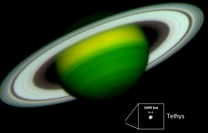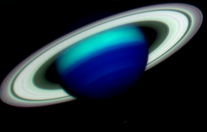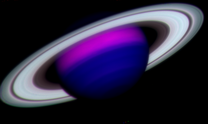
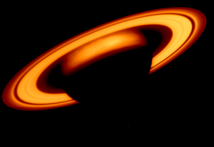
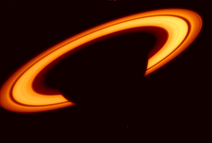
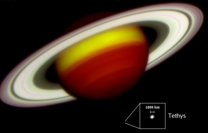
This false color image of Saturn was taken with the Arizona Infrared Imager and Echelle Spectrograph (ARIES) on December 8, 2005 at the focus of the f/15 adaptive secondary by Craig Kulesa and Donald McCarthy. Three narrow-band images comprise this RGB composite: an image taken at 1.64 um is referenced to red, 2.09 um is set to green, and 2.29 um to blue. The Saturnian moon Tethys (V=10.3), seen at the bottom of the image, was used to provide a wavefront signal for the adaptive secondary. On a night of median seeing, the adaptive correction yields 0.08" on-axis imaging, essentially the diffraction limit at K-band. The 0.18" image of Tethys is dominated by the angular size of the moon itself.
Saturn's visual appearance is controlled by the distribution and optical properties of clouds and haze. The three infrared bands provide dramatically different views of Saturn. The 1.64 um filter provides an image of the infrared continuum. From thermochemical equilibrium theory it is believed that we are seeing the top of an ammonia ice cloud which lies above deeper ammonium hydrosulfide and water/ammonia clouds. At 2.09 um, we witness partial absorption by neutral molecular hydrogen and methane. High altitude haze produces additional reflectivity in the equatorial bands. Finally, strong atmospheric methane absorption produces an image at 2.29 um in which the entire disk is absent!
